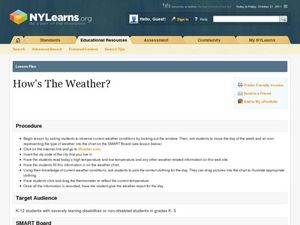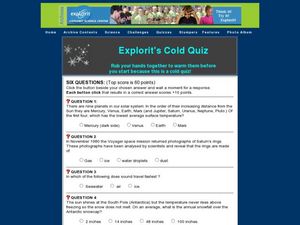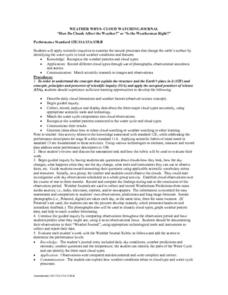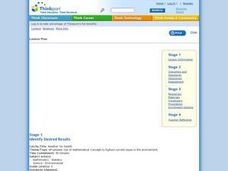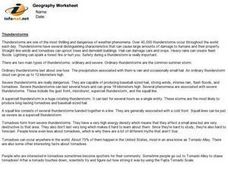Curated OER
How's the Weather
"How's the Weather?" is an exercise that combines science and math as students graph the weather along the Iditarod Trail. They complete a double-line graph of the weather of a chosen checkpoint over the course of one week. Students...
Curated OER
Climate
Pupils explore climate and weather conditions. Using the Internet, and other activities, students examine climate maps and the factors that affect climate. They examine how climate affects clothes, shelter, food, transportation,...
Curated OER
Climatology Forecasting
Learners make weather predictions using the climatology method. For this climatology lesson, students review using trends and persistence when forecasting weather. Learners discuss the climatology method for forecasting and complete the...
Curated OER
Introducing Temperature Measurement
Students read a thermometer, associate weather conditions and seasons with temperature changes and keep a record of daily temperature.
Curated OER
Rocks and Minerals
Learners identify how weathering and erosion effect the Earth's surface. In this weathering and rocks lesson, students study various types of rocks in water and brainstorm ways the Earth's surface changes. Learners view an interactive...
Curated OER
Qu¿¿ tiempo hace?
Students use the internet to gather information on Spanish cities and its weather. After completing a worksheet, they compare and contrast the weather conditions for the cities they researched. They share their information with the class.
Curated OER
What is Climate?
In this weather worksheet, students read a brief excerpt that compares the various types of climates found on Earth. Then they explain where the low- and high-pressure systems follow each other throughout the year.
Curated OER
Fronts
Fourth graders define cold and warm fronts, explain how they are formed and they ways that they affect the weather.
Curated OER
Explorit's Cold Quiz
In this cold quiz worksheet, students complete a six question multiple choice on-line interactive quiz about cold places and cold weather.
Curated OER
Clouds
Second graders explain what a cloud is, how it is formed and what the various types of clouds are. They do an experiment which shows them how to "make" a cloud, and write in their science journals about a "crazy weather day."
Curated OER
Understanding URLs
Study the different domain suffixes in web address becoming familiar with the types of organization that each suffix indicates. They evaluate web site using specified criteria.
Curated OER
The Reasons For The Seasons
Students investigate the different seasons that occur and how the weather is characterized according to the regions of The United States. They conduct research using the internet and then conduct classroom discussion while considering...
Curated OER
Home-Made Clouds
Fourth graders witness cloud formation in a jar during a teacher lead simulation. They research, draw and predict weather using information they gather about clouds.
Curated OER
Weather Whys- Cloud Watching Journal
Students examine how natural processes change the earth by identifying their local water cycle. Individual students complete a cloud journal over a specific period of time. They observe clouds daily and take photographs of the clouds...
Curated OER
Weather for Health
Ninth graders encounter various types of numerical information (represented in multiple ways), much of which is abstract and difficult to comprehend. In this lesson, 9th graders will convert given information into bar graphs. In the...
Curated OER
Thunderstorms
Fourth graders investigate the attraction between two different charges to explain the concept of lightning in a thunderstorm.
Curated OER
Thunderstorms
Fourth graders examine the attraction between two different charges to investigate lightning in a thunderstorm. They complete an experiment and a worksheet.
Curated OER
Tsunami
Young scholars examine what causes tsunamis and why they all behave differently. In this tsunami lesson students complete a group activity after viewing a video.
Curated OER
Cloud Observations using GLOBE Protocols
Students observe which of ten types of clouds are visible and how much of the sky is cloud covered. They see that by observing clouds, we can get information about temperature, moisture, and wind conditions in different places in the...
Curated OER
Cloudy With a Chance of Meatballs
The classic book, Cloudy With a Chance of Meatballs lesson plan, is used to help readers compare and contrast the weather in Chewandswallow to their own town. Students write their own fantasy weather story. This lesson plan is intended...
Curated OER
Isn't It Ironic?
After examining the definitions of situational, dramatic, and verbal irony viewers are presented with a series of situations and asked to label the type of irony each example represents. The photos alone make this slide show worth a look.
Virginia Department of Education
Hurricanes: An Environmental Concern
Hurricanes, typhoons, and tropical cyclones are the same type of storm, but their names change based on where they happen. Scholars use a computer simulation to learn about hurricanes. Then they hypothesize ideas to prevent hurricanes...
Curated OER
What is the Rock Cycle and Its Processes?
Geology beginners examine three different rock samples and determine their origin by their characteristics. By making and recording observations, they become familiar with features of igneous, metamorphic, and sedimentary rock types....
Curated OER
Clouds
In this clouds instructional activity, students respond to 3 different sets of questions related to the 3 types of clouds illustrated. First, they label each type of cloud illustrated in the pictures. Then, students draw a line from each...
